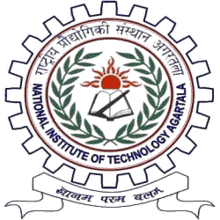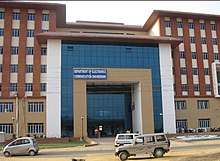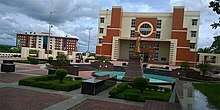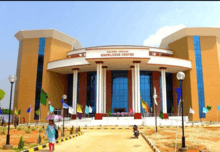National Institute of Technology Agartala
The National Institute of Technology, Agartala, shortened to NIT Agartala or NITA, is a technology-oriented institute of higher education established by India's Ministry of Human Resource Development Government of India in Agartala, India. It was founded as Tripura Engineering College in 1965 and declared a National Institute of Technology (NIT) in 2006, thus being recognised as an Institute of National Importance.
 | |
Former name | Tripura Engineering College |
|---|---|
Motto in English | Knowledge is the Supreme Power |
| Type | Public engineering school |
| Established | 1965; upgraded to National Institute of Technology in 2006 |
| Affiliation | Ministry of Human Resource Development Government of India |
| Chairman | Deepak B. Phatak |
| Director | Prof. H K Sharma[1] |
| Location | , , 23°58′N 91°25′E |
| Campus | 365.6 acres (1.480 km2) |
| Language | English |
| Colours | orange white black |
| Nickname | NITians,AGTians,NIT-A |
| Website | nita |
The Institute was established in 1965 as Tripura Engineering College, with the branches of civil, electrical, and mechanical engineering. It was initially affiliated with Calcutta University and had the same curriculum structure and examination system as Bengal Engineering College (currently IIEST Shibpur).

After the establishment of Tripura University in 1987, the Institute was affiliated with it. Courses toward a degree in computer science and engineering were offered beginning in the 1999 – 2000 session, and three new degrees were offered beginning in the 2005 – 2006 session: Electrical & Electronics, Production and Transportation Engineering.
On 23 February 2006, the Union Cabinet approved the proposal of the state government for the conversion of Tripura Engineering College to the National Institute of Technology.
Location
The Institute is 4 km off National Highway (NH-44) and about 24 km away from the capital city, Agartala. The nearest Rail station is about 2 km away, at Jirania.
Developments
The Institute was converted from Tripura Engineering College, a State Engineering College, to a National Institute of Technology in 2006. To better reflect this new status, the total seats were increased from 250 to 420 for the academic session 2007 – 2008 and undergraduate courses were introduced in electrical and electronics engineering, transportation engineering and production engineering. The Civil Engineering Department started a postgraduate programme in structural engineering to fulfill a state requirement. The campus, which had been nonresidential, was made residential for the 2007 – 2008 session with the reopening of two boys' hostels and one girls' hostel. The institute is built over 365.6 acres (1.48 km2) of land.
Rankings
| University and college rankings | |
|---|---|
| Engineering – India | |
| NIRF (2018)[2] | 92 |
| NIRF (2019)[3] | 70 |
NIT Agartala was ranked 70th among engineering colleges in India by the National Institutional Ranking Framework(NIRF) in 2019.[3]
Academics
NIT Agartala offers nine four-year undergraduate programmes in engineering. All undergraduate programmes lead to a Bachelor of Technology (BTech) degree. Post graduate Master's of Technology (MTech) courses in bio engineering, chemical engineering, civil engineering, computer science and engineering, electrical engineering, electronic and communication engineering, mechanical engineering and production engineering are also offered. From July 2013, dual-degree courses in engineering physics and a five-year integrated course in applied physics, chemistry and mathematics were started. NITA is the second NIT in India (after National Institute of Technology Calicut), and sixth among all NITs and IITs (Indian Institutes of Technology), to start a programme in engineering physics. The Department of Computer Science and Engineering offers a three-year degree leading to a Master's in Computer Applications (MCA) course. PhD and post-doctorate fellowships are offered by some departments. NIT Agartala also offers a CDAC programme.
Admission to the undergraduate programmes is based on the rank secured in the Joint Entrance Examination (Main). Candidates must also secure at least 75% marks in the 12th class examination, or be in the top 20 percentile in the 12th class examination conducted by the respective boards. For Scheduled Castes/Scheduled Tribes students, the qualifying marks would be 65% in the 12th class examination.
The NIMCET is a Common Entrance National Level Test, conducted by any of the NITs, for admission in to their MCA programme. The admission into the MCA programme of NIT-A is based on the Rank obtained in NIMCET exam only.
Departments
.jpg)


Academic departments
Engineering
- Department of Bio Engineering
- Department of Chemical Engineering
- Department of Civil Engineering
- Department of Computer Science and Engineering (Incorporates Dept. of MCA)
- Department of Electrical Engineering
- Department of Electronics and Communication Engineering
- Department of Electronics and Instrumentation Engineering
- Department of Mechanical Engineering
- Department of Production Engineering
- Engineering Physics (BTECH-MTECH)
Sciences
- Department of Chemistry
- Department of Mathematics
- Department of Physics
Management, Humanities & Social Sciences
Campus


Student life
Sports

Cultural Fest
NIT Agartala's cultural fest is known as Moksha.
Tech Fest
NIT Agartala's tech fest is known as Aayam.
Facilities

- Knowledge center (library)
- Computer center
- Student Activity center
- Gym (separate for boys and girls)
- College Cafeteria
- TT room and badminton court
- Medical Center
- Cricket/Football Ground
- Night canteen
- Wi-Fi across campus
- Carrom & many indoor games
Accreditation
In 2013, the mechanical and civil engineering branches of the Institute were accredited by the National Board of Accreditation for five years, while the electrical engineering branch was provisionally accredited for two years.[4]
References
- "Profile of Director, NIT Agartala" (PDF). Retrieved 2 December 2018.
- "National Institutional Ranking Framework 2018 (Engineering)". National Institutional Ranking Framework. Ministry of Human Resource Development. 2018.
- "National Institutional Ranking Framework 2019 (Engineering)". National Institutional Ranking Framework. Ministry of Human Resource Development. 2018.
- http://www.nita.ac.in/